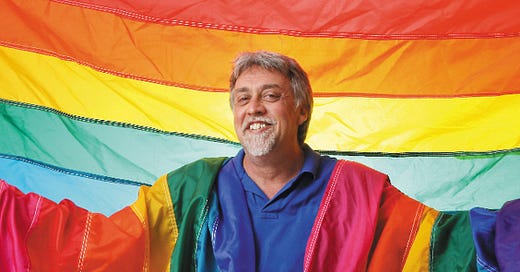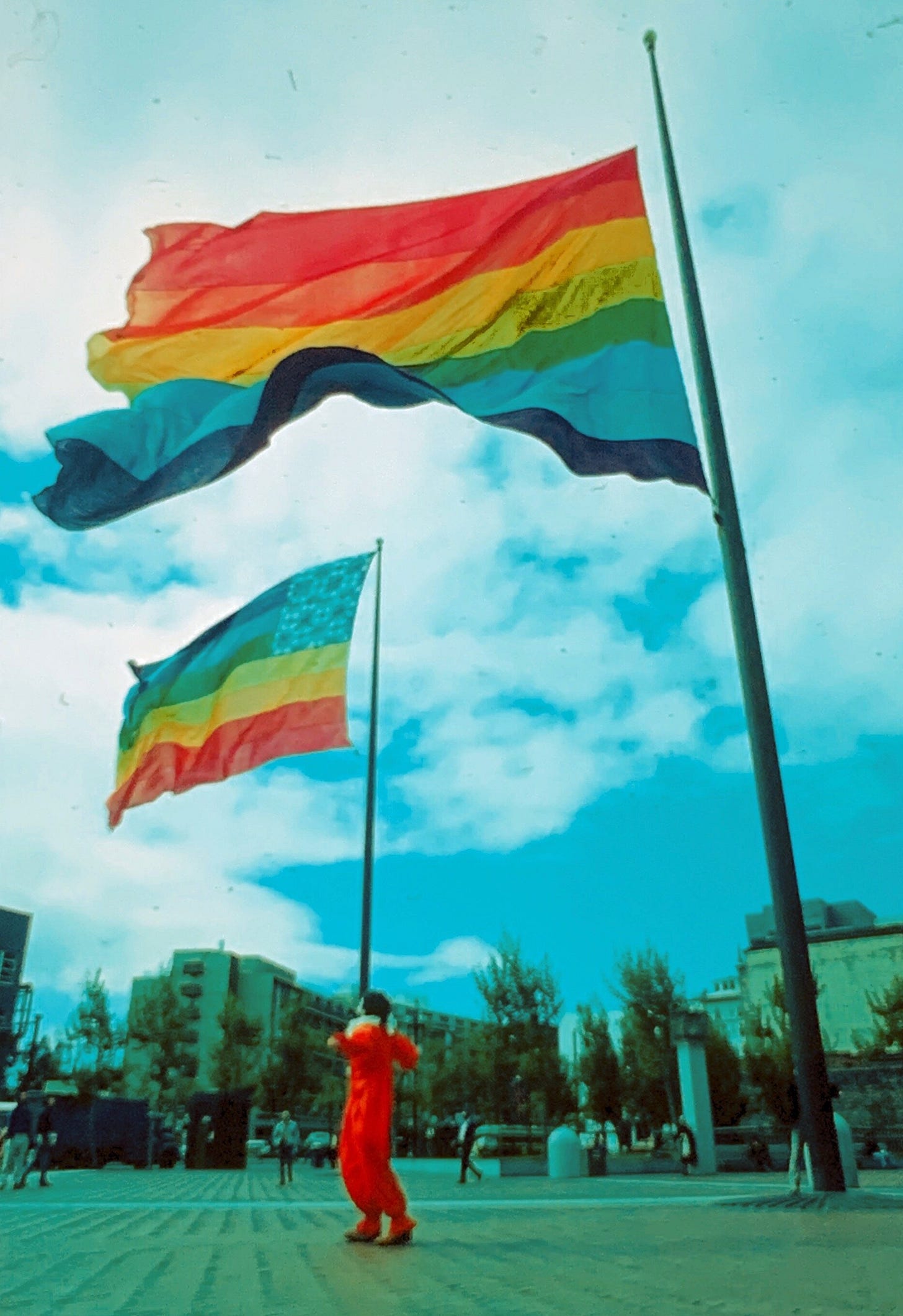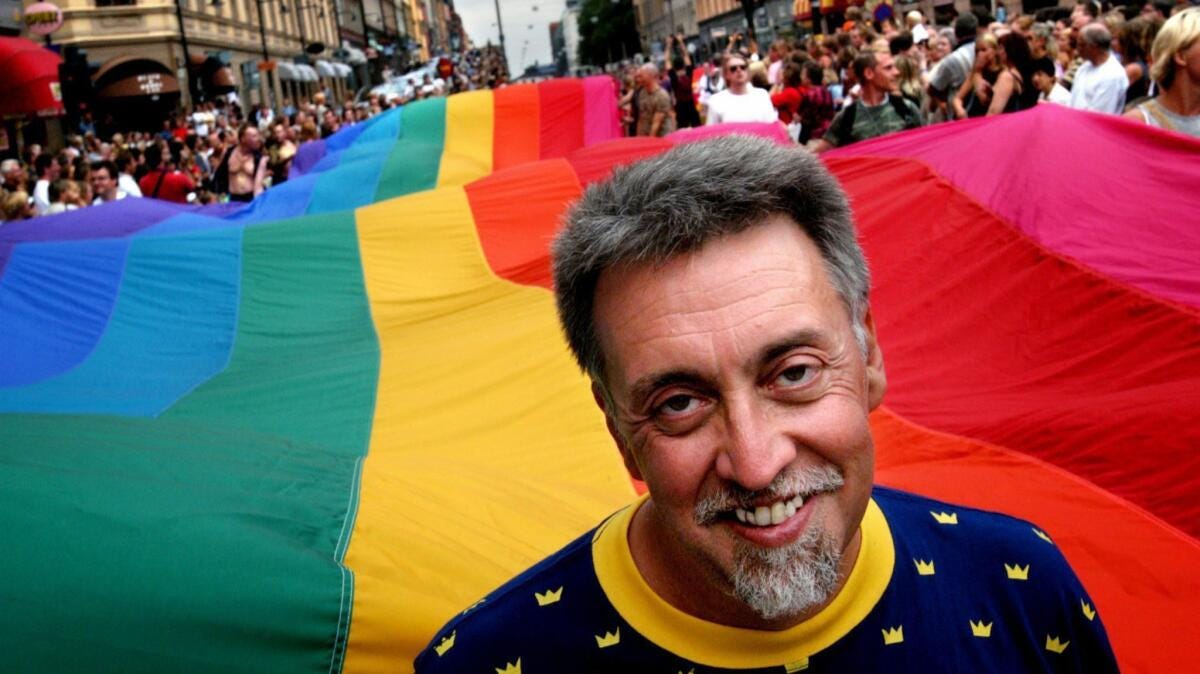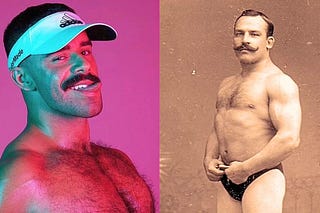
The Rainbow Flag is one of the most recognizable symbols on the planet—a bold, beautiful banner of color that waves with pride and purpose.
Behind that spectrum of color was a man with a sewing machine, a vision, and a whole lot of heart. His name was Gilbert Baker.
The Rainbow Flag is one of the most recognizable symbols on the planet—a bold, beautiful banner of color that waves with pride and purpose.
Behind that spectrum of color was a man with a sewing machine, a vision, and a whole lot of heart. His name was Gilbert Baker.
Every time I see a rainbow flag, I whisper: “Thank you, Gilbert.”
A LIFE IN COLOR
Gilbert Baker was born on June 2, 1951, in Chanute, Kansas. The future artist and “friend of Dorothy” grew up in a conservative environment, which made coming to terms with his sexuality anything but easy.
After serving in the US Army during the Vietnam War, Gilbert was stationed as a medic in San Francisco, just as the city was becoming one of the epicenters of the gay rights movement. Right man. Right place. Right time.
In 1970s San Francisco, Baker found both his people and his purpose.
A self-taught seamstress, Gilbert began designing and sewing banners for anti-war protests, drag performances, and pride marches. His wide-ranging talents—paired with his activism—caught the attention of Harvey Milk, one of the first openly gay elected officials in the US.
Harvey challenged Gilbert to create a new symbol for the gay community.
Something bigger than the pink triangle, which had been used as a badge of shame in Nazi Germany, but was being reclaimed by some as a symbol of strength.
Harvey knew Gilbert would make something joyful. Something unforgettable.
LET OUR RAINBOW FLAGS FLY
In 1978, Gilbert Baker didn’t just design the Rainbow Flag—he helped build it from scratch.
Alongside Lynn Segerblom, James McNamara, and more than 30 volunteers, he hand-dyed and stitched over 1,000 yards of fabric at the Gay Community Center in San Francisco. Together, they created the very first rainbow flags, which debuted on June 25, 1978, at San Francisco’s Gay Freedom Day Parade.
Two massive flags—each measuring 30 by 60 feet—brightened United Nations Plaza that day with their eight colored stripes, each symbolizing a different aspect of life:
Hot pink for sex
Red for life
Orange for healing
Yellow for sunlight
Green for nature
Turquoise for magic/art
Indigo for serenity
Violet for spirit
After that debut, fabric supply limitations (especially the unavailability of hot pink) led to the flag being simplified. Turquoise and indigo were eventually combined into a single royal blue stripe, resulting in the six-color rainbow flag we know today:
Red, Orange, Yellow, Green, Blue, Violet
This streamlined version gained traction especially after the tragic assassination of Harvey Milk later that year, when the LGBTQ+ community was in desperate need of a unifying symbol of resilience, strength, and hope.
“I decided that we should have a flag, that a flag fit us as a symbol, that we are a people, a tribe if you will. And flags are about proclaiming power, so it's very appropriate.”
Gilbert Baker
With the Rainbow Flag, Gilbert Baker gave the LGBTQ community a lasting symbol that shouted in color what so many had only whispered in secret.
Baker never trademarked the flag. He wanted it to belong to everyone. And it does.
Creating art and advocating for LGBTQ rights until his death in 2017, Baker’s work lives on—in every rainbow patch, sticker, t-shirt, and parade float.
Gilbert’s flag is everywhere.
It’s a signal. It’s a comfort. It’s a challenge.
It says: We’re here. We’re queer. We’re making history, dear.
One man with a vision, a sewing machine, and a dream gave us all permission to live our lives loudly, proudly, and in full-spectrum color.
So yes, every time I see a rainbow flag, I still whisper, “Thank you, Gilbert.”
Keep calm and get your Pride ON!
Clint 🌈✌️
COLLIDE PRESS is a reader-supported publication.
Please consider becoming a paid subscriber or patron.
Big thanks to all who’ve subscribed and/or supported!
FYC = LGBTQ STORIES + SUBSTACKS
ON THIS DAY = JUNE 2
BIRTHDAYS
1740 = Marquis de Sade = French aristocrat and politician 🌈
1904 = Johnny Weissmuller = Hungarian-American swimmer and actor
1921 = Betty Freeman = American photographer and philanthropist
1937 = Sally Kellerman = American actor
1941 = Charlie Watts = English drummer, songwriter, and producer
1941 = Stacy Keach = American actor
1944 = Marvin Hamlisch = American composer and conductor
1946 = Lasse Hallström = Swedish filmmaker
1948 = Jerry Mathers = American actor
1950 = Brent Hawkes = Canadian pastor and activist 🌈
1951 = Gilbert Baker = American artist 🌈
1953 = Cornel West = American philosopher, author, and academic
1954 = Dennis Haysbert = American actor and producer
1955 = Dana Carvey = American comedian and actor
1968 = Andy Cohen = American television host 🌈
1972 = Wayne Brady = American actor, comedian, game show host, and singer 🌈
1972 = Wentworth Miller = American actor and screenwriter 🌈
1977 = Zachary Quinto = American actor 🌈
1978 = Dominic Cooper = English actor
1978 = Justin Long = American actor
1979 = Morena Baccarin = Brazilian-American actor
1988 = Awkwafina = American actor, rapper, and comedian
EVENTS
1896 = Guglielmo Marconi applies for a patent for his wireless telegraph.
1910 = Charles Rolls, a co-founder of Rolls-Royce Limited, becomes the first man to make a non-stop double crossing of the English Channel by plane.
1953 = The coronation of Queen Elizabeth II becomes the first British coronation and one of the first major international events to be televised.
1973 = Della Aleksander co-presented an episode of BBC’s Open Door on transgender women's lives.
1989 = The first Lambda Literary Awards are presented as part of the American Booksellers Association convention in Washington, D.C. Armistead Maupin is the emcee. “Lammy” winners include Dorothy Allison, Paul Monette, Michael Nava, and Edmund White.
HOLIDAYS + OBSERVANCES
Pride Month (ongoing)
PORTRAIT + QUOTES OF THE DAY
“A true flag is not something you can really design. A true flag is torn from the soul of the people. A flag is something that everyone owns, and that's why they work. The Rainbow Flag is like other flags in that sense: it belongs to the people.”
Gilbert Baker
“In 1978, the first flag was organic everything. It did have eight colors: the six colors of the rainbow we see today plus hot pink and turquoise. But pretty quickly on I realized that I would never be able to satisfy the demand for them by hand-dying fabric and these colors.”
Gilbert Baker




















Thanks Clint and Gilbert Baker. ❤🧡💛💚💙💜🤎🖤. Currently listening to Renee Elise Goldsberry singing Out Tonight from Rent. 🎹🎹🎹 Aaaaoooooout tonight
Such a wonderful article and fascinating piece of history I never knew. Always great to learn something new especially when its filled with positive energy. Thanks so much for bringing this to your readers.